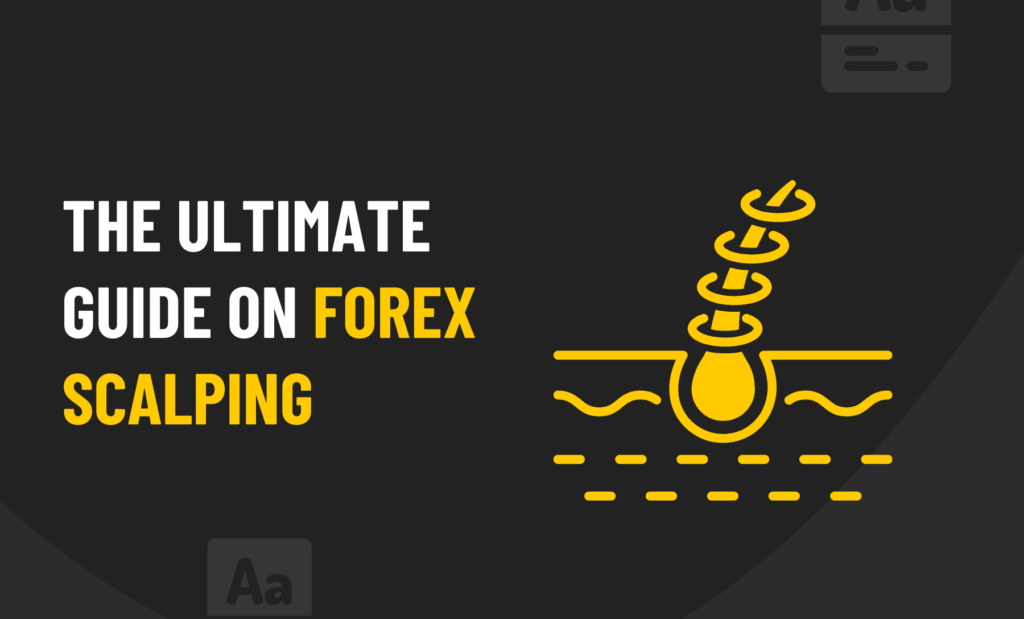Table of Contents
What is Forex Scalping?
Before we dive into scalping in Forex…
What is Forex scalping exactly?
The Forex scalping strategy is a type of trading strategy that involves traders making numerous small trades through the day on small movements to get financial gains rather than buying and holding for longer periods of time. Scalping is the same as skimming, so you get whatever is right on top, so those few amount of pips per movement.
Scalping is a trading technique rather than an investment strategy. This is because Forex traders that classify as investors hold positions and movements for longer-term and aim for an overall gain. Scalpers are those that probably fall under some that want to “get rich quick” by making a profit as fast as possible on many small position changes.
These fast movements can move in individual tick marks of time, so even a day trader’s technique of using time intervals of five to thirty minute windows is often too long of a wait to exit after placing an order. Within these time intervals, a successful Forex scalper will aim at a profit of five to ten pips per trade. (remember a pip is .0001, so scalping aims at .0005-.001 as a gain)
As you will be skimming off small movements, there is no guaranteed time structure that other strategies have. This means maybe you exit a minute or two after entering, or holding a position for fifteen minutes to see how it is going to play out.

Photo Credit: Forexlive
What Do You Need for Forex Scalping?
Becoming a Forex scalper does not need anything special aside from having a higher tolerance for risk and time to develop skills and learn the art of trading on the market manually.
Being a Forex scalper comes down greatly to your personality type and desires rather than toolkits. You must also be able to have the time to live by your screen because of how short the window for movements can be…walking away is not much of an option. You walk away when your trades are done for the day.
After opening your Forex account, you are ready to go. There is no set one currency pair that is best for scalping, but rather this type of strategy is about watching currency pairs that are making small upward movements. This is going to vary day by day depending on the market and economy.
Although there is not necessarily a single best currency pair to stick with when scalping, there are some that may be more apt to perform better under these conditions depending on the daily market. These currency pairs are often within the major pairs category as they are the most stable and semi-predictable for movements and more commonly traded as well. Some minor currencies cycle in ways that will allow scalpers to be successful though as well.
These potential pairs can be EUR/USD, AUD/USD, GBP/USD and AUD/GBP.
You need to know how to read technical analysis well. This is going to be key to knowing when to make a move based on what the market is doing as with Forex scalping you do not have long between buying and selling your positions.
Part of your Forex scalping strategy should also include knowing how to read candlestick patterns very well. These charts are going to be your best signals at how and when to make your move to make those minute gains.
Overall, to effectively be a Forex scalper, you need to be best friends with chart patterns. Different patterns will show different points from which you can benefit the most from. Knowing how the market is going to turn and being able to predict certain points will be a key to success for scalping.
Let stop-loss orders be your buffer and guide. As with nearly any strategy in Forex, stop-loss orders help create a safety net of sorts for you as a trader. This means that once these are in place, risk and loss can be managed a bit easier. Scalping is a bit higher risk, so pairing it with stop-loss orders can help make it a bit more tolerable.
Also, make baby steps for bigger gains. This is a heavy reminder for a Forex scalping strategy. Forex scalping is about tiny movements spread over time, do not make a large movement or use a large number of funds or leverage in a move. This strategy is a good way to have large losses due to the nature of how scalping works and the risk associated.
One last tip is you need to be a cool cucumber. Emotional moves will be your downfall in the world of Forex scalping. Acting rash will cause you to move too fast or too slow, or too much of any one way and then lead you to have large losses and your overall strategy for trading on Forex will end up falling apart.
Pros of Forex Scalping
An initial pro to using a scalping Forex trading strategy is that, unlike most other techniques, when you are done trading for the day you are done. Each day you will enter and exit all of your trades. This means there is nothing open at the end of the day and open while you are asleep. As Forex is a twenty-four-hour market, some traders may take hits while sleeping, so with Forex scalping, you can rest easy knowing nothing volatile is happening to your account while you are away.
Another advantage to Forex scalping is that scalpers tend to have an easier time building their account. Because of the nature of the amount of daily trades and movement types, compounding on trades often comes a bit easier with this strategy type than with others.
A Forex scalping strategy also means that as a trader, your day can be made to be short. Although you need to be glued to your screen to monitor movement, keeping trades to time intervals less than that of the average trader means you are only actively trading for a short window of time. This means you can be a part-time trader and still make a profit if executed well.
Cons of Forex Scalping
Concentration skills must by high on your list as a Forex scalper. This can be a pitfall for many people that may have trouble concentrating intensely in the time required to trade this way and pair it with a level of monotony of repeating the same task type over and over with lack of variety.
You will not be able to execute or celebrate big moves like other trading strategies if you are scalping Forex. Again, scalping is all about small movements, which means each trade is likely to be a smaller gain, but just done more frequently. Those that buy and hold in more traditional techniques are much more likely to get to have a big win and see big movements. So this can end up having an emotional toll on you as a trader if you desire to see massive portfolio improvements.
Profits can end up down the drain quickly if not careful using a Forex scalping strategy. Given that profit is made in tiny amount of pips while scalping, a sudden large change or miscalculation can quickly eat into potential profits or end up causing a loss.
So, Is It Profitable?
At the end of the day, Forex scalping can be a profitable technique when deciding to be a Forex trader. As mentioned above, it does take some skill and ability to react fairly quickly under various market conditions, so it may not be best suited for beginner FX traders.
Being a Forex scalper means having patience, emotional tolerance and risk tolerance to the market while being dedicated to the technique. Forex scalping is the art of tiny gains over time to make a profit, so if you can handle not having large wins at once and being able to be quick to react, Forex scalping may be for you.
Scalping is often a strategy best used by those that are very familiar with the Forex market. Knowing how to read charts and analytics and be able to react immediately at any point is often not a beginner skill. So, if you are still a novice trader and are interested in scalping, be sure you are fully prepared.
If you are a beginner scalper and want the best chance of making a profit, you will want to start with a one minute based strategy. This means your time frames are set minute by minute to easier spot the movements you are looking for. As you become more experienced, you will be able to change the time frame as you get used to how certain events and times of day affect the market on a smaller scale.




